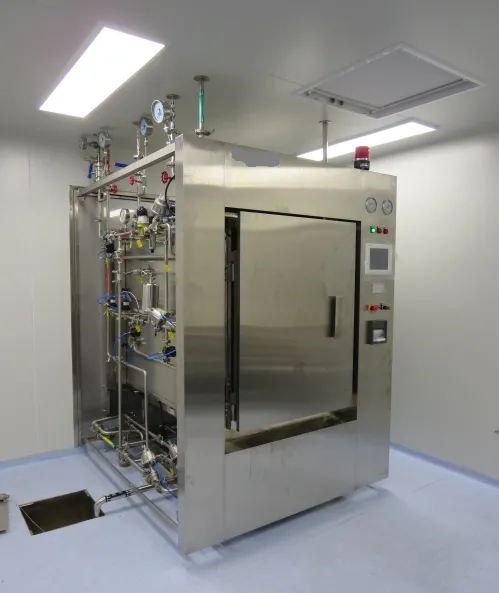Steam sterilization principle:Several basic knowledge of high pressure steam sterilizer
Author: OSR & Vanessa 18 Jan. 2025 Category: Sterilizer
How high-pressure steam sterilizer works
A sterile environment is very important in situations where the presence of bacteria poses a major safety hazard, especially for hospitals, research laboratories, biopharmaceutical companies, food production lines, etc.
Sterility Assurance Level, or SAL, also known as the probability of microbial survival, determines the probability of microorganisms surviving during the sterilization process. The general standard for SAL is that the probability of a single live microorganism surviving is 10⁻⁶, that is, the probability of a surviving microorganism on the product after sterilization does not exceed one in a million. Meeting this mark is considered sterile.
Different types of items require different sterilization times, which is called a complete sterilization cycle. At different temperatures, only when the items are sterilized for the sterilization time can they be used safely. One way to achieve sterility of goods is steam sterilization.
In order to kill a cell, you need three conditions, temperature, pressure, and time. All three parameters must be met to sterilize the product. Let’s start with temperature. First, you need to increase the temperature to the point where the proteins in the cell wall break down and work together. Steam latent heat is perfect for this because it is a very efficient heat transfer medium. It usually takes five hundred and forty kilocalories to heat one liter of water from its boiling point of 100 degrees Celsius to steam, which means that 100 degrees Celsius steam contains seven times the energy of 100 degrees Celsius water. When steam condenses on an object, all of this energy is immediately transferred to the product being sterilized, and steam is much more efficient at killing cells than air at a similar temperature, which is why we use steam to achieve sterility.
Now let’s talk about how a pulsating vacuum sterilizer works. A pulsating vacuum sterilizer, also known as a moist heat sterilizer, uses the latent heat released by saturated steam to kill any microorganisms that may be present on the contaminated load. The sterilizer forms a sealed chamber after the door is closed, and the air in the chamber is forced out by injecting steam after the vacuum to prevent cold spots in the sterilizer chamber, and then injecting steam to achieve sterilization. After the sterilization process is over, the items can be removed.
There are seven main stages in the pulsating vacuum sterilization cycle.
The first stage – preheating:
steam is injected into the jacket to increase the temperature of the inner wall of the cylinder to reduce the condensation water generated after the steam is injected into the inner chamber;
The second stage – pulsating vacuum:
the air in the inner chamber is forcibly removed by the vacuum pump, and then steam is injected through several reciprocating cycles to ensure that there is no air in the inner chamber;
The third stage – heating:
saturated steam is injected into the inner chamber to fully contact the sterilized items in the inner chamber with steam so that the temperature and pressure of the inner chamber reach the set value;
The fourth stage – sterilization:
after the temperature and pressure of the inner chamber reach the set value, The sterilized items will be in a constant temperature stage, and the sterilization will end after the set time is reached;
The fifth stage – exhaust:
exhaust the steam in the inner chamber, reduce the pressure in the inner chamber to the set pressure and end the exhaust;
The sixth stage – drying:
after the exhaust is completed, in order to ensure the dryness of the surface of the sterilized items, the steam and moisture in the inner chamber and the sterilized items are extracted by vacuum;
The seventh stage – end:
after the drying is completed, the outdoor air is added to the inner chamber through the sterile air filter to replenish sterile air, so that the inner chamber returns to the ambient pressure.
The pulsating vacuum sterilizer includes the following components:
The pulsating vacuum sterilizer is mainly composed of the sterilizer body, the pipeline system, and the electrical automatic control system. The external HMI is used as the operation interface to realize the operation and control of the sterilizer. The key information such as the temperature, pressure, F0 value, and operation stage of the inner chamber are displayed in real time on the HMI, and the key operation data are printed in real time through the micro printer during the operation.
Next, we will discuss the standard procedures for implanting the sterilizer.
Standard implantation procedures include: fabric, instrument, culture medium, BD test, and leak test
The three standard procedures of fabric, instrument, and culture medium can set the sterilization temperature, pressure, sterilization time and other parameters in the process menu according to the sterilization process, and can save the set parameters in the process formula according to different specifications and models of products. When sterilizing, select the appropriate process formula in the process formula drop-down menu for sterilization.
The BD test procedure is mainly to test the heat penetration ability of steam in the standard sterilization package, and judge whether the sterilization can meet the requirements by the color of the test paper.
The leak test procedure is mainly to test the sealing ability of the sterilizer under vacuum state, to prevent the external air from being sucked into the inner chamber of the sterilizer under vacuum state, and to ensure the sterilization effect.
It is worth noting that for items that cannot be sterilized by steam high temperature for a long time, chemical gas sterilization, liquid immersion, ionizing radiation and other methods that do not generate high temperature are usually used to achieve the purpose of disinfection and sterilization.
This is a beginner’s guide. If you want to know more about wet heat sterilization products, talk to the sterilization experts of OSR Medical Technology today.

